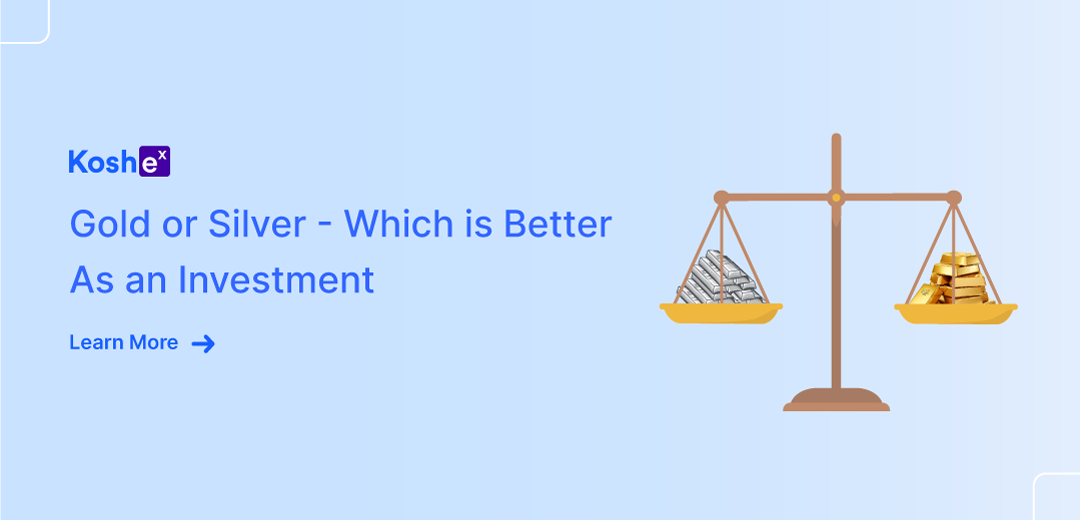Investing in precious metals has been a timeless fascination for humanity. Generations and borders have not been able to escape the allure of gold and silver’s sparkle for centuries. People have valued precious metals for their aesthetic appeal and also for their intrinsic value.
Gold and silver are recognized as a store of value and a hedge against economic uncertainties. This article will look at why gold and silver are good investment options. It will explore the historical significance, the comparative analysis of investing in each of the investments, and the factors that make gold or silver investments compelling options. Invest with ease in these precious metals by signing up with Koshex.
Understanding Gold and Silver as Investments
Gold and silver are tangible assets that retain value over time, making them appealing during market downturns and high inflationary periods. They serve as a store of value and offer diversification in investment portfolios due to their lower correlation with traditional financial markets. They offer a sense of security and long-term wealth preservation, acting as a hedge against currency devaluation.
Gold is accepted and recognized as a safe-haven asset during economic downturns and geopolitical crises. It effectively preserves wealth over extended periods, providing a secure investment option.
On the other hand, with its dual use, the price of silver is influenced by both investment demand and industrial consumption, rendering it relatively more volatile compared to gold. This duality attracts investors seeking exposure to both precious metal markets and industrial applications. It has significant industrial applications in sectors like technology, medicine, and renewable energy.
Also Read : Exploring the Benefits of Investing in Digital Gold
How to Identify If Gold or Silver Is the Right Investment for You
Investing in gold or silver can be suitable for a range of investors, depending on their investment objectives, risk tolerance, and overall portfolio diversification strategy.
Conservative Investors
Those looking for stability and a hedge against economic uncertainties may prefer gold and silver. Conservative investors often value capital preservation over high returns and seek to protect their portfolios from inflation and market volatility.
Diversification Seekers
Investors aiming to diversify their portfolios by adding assets that have a low correlation with traditional investments might consider gold or silver. Both metals often move independently of other financial assets, which can help balance the overall risk in a portfolio.
Long-Term Investors
Individuals with a long-term investment horizon who wish to hedge against inflation or preserve wealth should opt for gold or silver. Over extended periods, these metals have historically retained their value, making them a good choice for those seeking to safeguard their purchasing power.
Risk-Averse and Cautious Investors
Those wary of economic instability, currency devaluation, or stock market volatility might lean towards gold or silver. The stability and security offered by these metals often attract risk-averse investors seeking a safe haven for their wealth.
Individuals with Portfolio Balancing Objectives
Investors looking to balance risk and returns across their investment portfolio might find that including gold or silver can help cushion the impact of market fluctuations and provide a degree of stability.
However, it is important to note that the suitability of gold and silver as investments varies for each individual, and their inclusion in an investment portfolio should be based on an investor’s specific financial goals, risk profile, and overall portfolio structure.
How Can Gold or Silver Add Value to a Portfolio?
Gold and silver can add value to an investment portfolio in several ways, and they are mentioned as follows:
Diversification
Incorporating gold or silver into a portfolio can offer diversification benefits. These metals have a low correlation with other financial assets, such as stocks and bonds. When traditional markets are volatile or experiencing downturns, gold and silver often behave differently.
Wealth Preservation
In times of economic uncertainty or rising inflation, the value of these metals tends to increase, helping to preserve purchasing power and wealth.
Liquidity
Gold and silver markets are highly liquid. They can be easily bought and sold in various forms. Due to this liquidity, investors have the flexibility to enter or exit positions quickly without significant price impact.
Portfolio Protection
The stability of gold and silver can offer protection against currency fluctuations and global economic events. Even in a balanced portfolio, they can offset losses incurred in other asset classes, reducing overall portfolio risk.
When considering the addition of gold and silver to an investment portfolio, it is crucial to evaluate one’s investment goals, risk tolerance, and time horizon. These metals can safeguard against economic uncertainties and market fluctuations, but their suitability depends on an individual’s overall investment strategy.
Also Read: Best Method To Buy Or Invest In Gold & Gold Investment Methods
Comparative Analysis of Investing in Gold and Silver
While making a choice between gold and silver, it is important to weigh and compare several crucial factors, along with your financial circumstances. Here are some key considerations:
| Point of Difference | Gold | Silver |
| Market Size | Larger market size | Smaller market size |
| Price Volatility | Lower price volatility | Higher price volatility |
| Industrial Demand | Limited industrial use | Significant industrial applications |
| Historical Price Ratio | Historically, higher price compared to silver | Historically, lower prices compared to gold |
| Physical Demand | Strong physical demand for jewelry and investment | Significant physical demand for industrial and investment purposes |
| Supply | Relatively stable supply | Often marked by supply shortages |
| Storage Costs | Lower storage costs | Higher storage costs |
| Correlation | Less correlated with economic indicators | More correlated with industrial trends |
| Accessibility | High liquidity, easily traded | Relatively lower liquidity, less traded |
The decision between investing in gold or silver depends on individual preferences, financial goals, and risk tolerance. Gold stands out as a reliable, time-tested store of value, particularly during economic turmoil, preserving wealth over extended periods. Whereas silver is more accessible for small investors due to its lower price point.
Also read: How To Invest In The Best Gold Funds & ETFs?
Bottom Line
Gold and silver contribute to risk management strategies by adding diversification and security against market uncertainties, enhancing the overall stability of an investment portfolio.
The choice between gold and silver as an investment depends on your financial objectives and circumstances. Both of these metals offer distinct benefits and considerations. You should align your goals and make comparisons between both of these precious metals before making any investment decisions.
If you are ready to embark on your precious metal investment journey, sign up with Koshex for expert guidance and support.
Frequently Asked Questions
Q1. What are the key historical factors that have influenced the value of gold and silver as investments?
Ans. Throughout history, gold has been used as a store of value, a medium of exchange, and a hedge against economic uncertainties. The historical performance of both metals has been influenced by factors such as economic stability, currency devaluation, inflation, technological advancements, and geopolitical events.
Q2. Can I use gold and silver investments as a hedge against economic downturns or inflation?
Ans. Yes. Both gold and silver investments are commonly used as hedges against economic downturns and inflation. Precious metals have historically demonstrated their ability to retain value during times of economic instability or declining currency values. By diversifying your portfolio with gold and silver, you can potentially reduce the impact of economic uncertainties and inflation on your overall investments.









Leave a Comment